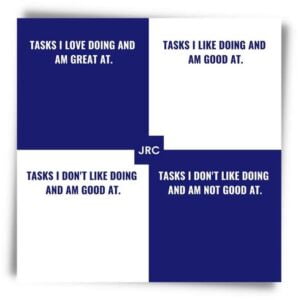YOUR FOCUS IN QUARTER 3
As we enter Quarter 3 of 2022, it is time to reflect on how far you have gotten on your goals over the last six months, what has worked well, what has not, and what you will keep, start and stop doing. Make the next quarter matter. Continuous execution of small daily changes leads to tremendous results.
NARROW YOUR FOCUS IN Q3
As a business consultant, strategist, and executive coach, I work with successful companies and leaders who share a common practice of conducting quarterly reviews and previews.
By starting each quarter with an initial review, you are taking the time to set a benchmark and do a post-mortem on the past three months’ activity and results.
Analyze wins, identify ongoing challenges, and reflect on lessons learned. Evaluate what you will continue to focus on, what you will stop doing and new initiatives and priorities that need to be implemented.
After the review, you then move on to a preview of what is upcoming in the following 90-day period and identify priorities. These 90-day/quarter priorities ensure alignment and provide a transparent and clear focus.
‘You will either look back in life and say I wish I had, or I’m glad I did.’
– Zig Ziglar
QUARTERLY REVIEW PROCESS
- REVIEW your cash flow and identify your top five activities that provide you profit.
- ANALYSE your Key Performance Indicator (KPI) results, shortfalls and gaps. This activity will assist in the identification of areas that require your attention. Your KPIs drive your triple-bottom-line results and can often simply be viewed in terms of profit margin per:
a. employee
b. customer or client, and
c. production or delivery. - IDENTIFY your core areas that can be improved upon to increase operational efficiencies. Quarterly process optimization goals are an excellent way to look at this with your team. Creating core processes saves time and provides standard operating procedures, combined with checklists that can reduce errors and increase efficiencies.
- REVIEW your long-term strategic initiatives and identify at least one that you can focus on in Q3 that aligns with your vision, will bring value to your team and stakeholders, and will add value to your customers and clients.
WHAT IS ONE THING YOU CAN DELEGATE THIS QUARTER?
Have you recently thought/said,
‘I don’t have enough time,’
‘There is too much to do,’
‘I never have enough time to focus on what is essential?’
If so, it’s time to evaluate how you spend your time and on what.
STEP 1. List at least 20 things you do in your job or on a day-to-day basis, the more detail you have in your list, the better.
STEP 2. Draw up a quadrant and in each box, write the topics you see on the image below.

STEP 3. Of all the items you listed in Step 1, please put each one into the most relevant quadrant. Tally how many you have in each quadrant.
STEP 4. Your objective should be to have most items in the top left quadrant. Everyone is more effective and productive when they work to their strengths and are engaged. If your quadrants are bottom-heavy, work towards making some changes and, when possible, delegate a minimum of one task per quarter to others where they may be a better fit.
‘The difference between successful people and really successful people is that really successful people say no to almost everything.’
– Warren Buffett
QUARTERLY THINKING
ONE: What do you want to accomplish by the end of Q3?
TWO: How will you unwind, unplug and recharge to ensure you bring the best version of yourself to the job weekly?
THREE: Identify three core professional areas of strength and three core areas of weakness. In Q3, aim to work more in your areas of strengths and do some professional development work in at least one area of challenge to help you improve in the job.
FOUR: Identify at least five areas you can say ‘no’ to this quarter. One of my TEC members, Joseph Fry, Founding Principle of Hapa Collaborative, operates under a ‘hell yes’ or ‘hell no’ system when defining where he will spend his time. I love his energy and focus on working in areas that matter to the business.
If you have any questions about your quarter 3 review and planning or want to learn more about the powerful benefits of executive coaching to elevate your professional success, please reach out to +1 604-616-1967 or jenny@jennyreilly.com and book a complimentary 30-minute strategy session. If you want monthly leadership and professional development tips, sign up for my JRC newsletter or check out my social media on Instagram for top leadership advice throughout the year.

